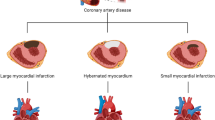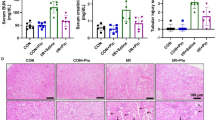Abstract
The aim of this study was to examine and compare the effects of the acute administration of verapamil or amlodipine as representatives of the calcium channel blockers or nicorandil as a representative of the mitochondrial ATP-dependent potassium (KATP) channel opener to cardiac contractility, coronary flow, and oxidative stress markers on ischemia/reperfusion injury in the isolated rat heart. The hearts of adult male Wistar albino rats (n = 60 total, 12 per group) were divided into five groups, two controls (preconditioning with Krebs–Henseleit solution) and three experimental depending on acute administrated pharmacological agents (0,63 µmol/L of verapamil, 0,1 µmol/L of amlodipine, and 200 µmol/L of nicorandil). After stabilization and 5 min of preconditioning in experimental groups, hearts from I/R control and all experimental groups underwent global ischemia (20 min) and reperfusion (30 min). Hearts from sham group were continuously followed for 50 min, after stabilization period. Cardiodynamic parameters and coronary flow were recorded at the end of stabilization (S), at the last minute of pharmacological preconditioning (P) and at intervals of 5 min after global ischemia, during reperfusion, or in case of sham group during 20–50 min after stabilization. At the same intervals, we collected coronary venous effluent from which we spectrophotometrically measured the parameters of oxidative stress: the index of lipid peroxidation, superoxide anion radical, hydrogen peroxide, and nitrite. In summary, our findings clearly indicate that the blocking of the calcium channel or the activation of KATP may mediate the protective effect of myocardial preconditioning. The ex vivo results showed that all examined drugs after ischemia and reperfusion have beneficial cardioprotective properties associated with lower values of major pro-oxidative molecules. Obtained effects seem to be the most convincible in case of nicorandil.


Similar content being viewed by others
References
Yang Q, He GW, Underwood MJ, Yu CM (2016) Cellular and molecular mechanisms of endothelial ischemia/reperfusion injury: perspectives and implications for postischemic myocardial protection. Am J Transl Res 8:765
Cadenas S (2018) ROS and redox signaling in myocardial ischemia-reperfusion injury and cardioprotection. Free Radic Biol Med 117:76–89
Kiselyov K, Muallem S (2016) ROS and intracellular ion channels. Cell Calcium 60:108–114
Cao CM, Xia Q, Gao Q, Chen M, Wong TM (2005) Calcium-activated potassium channel triggers cardioprotection of ischemic preconditioning. J Pharmacol Exp Ther 312:644–650
Kwong JQ, Molkentin JD (2015) Physiological and pathological roles of the mitochondrial permeability transition pore in the heart. Cell Metab 21:206–214
Morciano G, Giorgi C, Bonora M, Punzetti S, Pavasini R, Wieckowski MR, Campo G, Pinton P (2015) Molecular identity of the mitochondrial permeability transition pore and its role in ischemia-reperfusion injury. J Mol Cell Cardiol 78:142–153
Altamirano F, Wang ZV, Hill JA (2015) Cardioprotection in ischaemia-reperfusion injury: novel mechanisms and clinical translation. J Physiol 593:3773–3788
Kojima A, Fukushima Y, Ito Y, Ding WG, Kitagawa H, Matsuura H (2018) TRPC channel blockers improve ventricular contractile functions after ischemia/reperfusion in a Langendorff-perfused mouse heart model. J Cardiovasc Pharmacol. https://doi.org/10.1097/FJC.0000000000000566
Piper HM, Meuter K, Schafer C (2003) Cellular mechanisms of ischemia-reperfusion injury. Ann Thorac Surg 75:S644–S648
Hausenloy DJ, Yellon DM (2013) Myocardial ischemia-reperfusion injury: a neglected therapeutic target. J Clin Investig 123:92–100
Venkatesh N, Lamp ST, Weiss J-N (1991) Sulfonylureas, ATP-sensitive K1 channels, and cellular K1 loss during hypoxia, ischemia, and metabolic inhibition in mammalian ventricle. Circ Res 69:623–637
Nichols CG (2016) Adenosine triphosphate-sensitive potassium currents in heart disease and cardioprotection. Card Electrophysiol Clin 8:323–335
Simonovic N, Jeremic J (2017) Role of calcium channel blockers in myocardial preconditioning. Ser J Exp Clin Res 18:281–287
Gross GJ, Auchampach JA, Maruyama M, Warltier DC, Pieper GM (1992) Cardioprotective effects of nicorandil. J Cardiovasc Pharmacol 20:S22-8
Ahmed LA, Salem HA, Attia AS, Agha AM (2011) Pharmacological preconditioning with nicorandil and pioglitazone attenuates myocardial ischemia/reperfusion injury in rats. Eur J Pharmacol 663:51–58
Herr DJ, Aune SE, Menick DR (2015) Induction and assessment of Ischemia-reperfusion injury in Langendorff-perfused rat hearts. J Vis Exp 101:e52908
Miyawaki H, Ashraf M (1997) Ca2+ as a mediator of ischemic preconditioning. Circ Res 80:790–799
Mitani A, Kinoshita K, Fukamachi K, Sakamoto M, Kurisu K, Tsuruhara Y, Fukumura F, Nakashima A, Tokunaga K (1991) Effects of glibenclamide and nicorandil on cardiac function during ischemia and reperfusion in isolated perfused rat hearts. Am J Physiol 261:H1864-71
Ohkawa H, Ohishi N, Yagi K (1979) Assay for lipid peroxides in animal tissues by thiobarbituric acid reaction. Anal Biochem 351:8–16
Green LC, Wagner DA, Glogowski J, Skipper PL, Wishnok JS, Tannenbaum SR (1982) Analysis of nitrate, nitrite and [15N] nitrate in biological fluids. Anal Biochem 131:8–17
Auclair C, Voisin E (1985) Nitroblue tetrazolium reduction. In: Greenvvald RA (ed) Hadnbook of methods for oxygen radical research. CRC Press Une, Boca Raton 123:32–48
Pick E, Keisari Y (1980) A simple colorimetric method for the measurement of hydrogen peroxide produced by cells in culture. J Immunol Methods 38:161–170
Lefrandt JD, Heitmann J, Sevre K, Castellano M, Hausberg M, Fallon M, Urbigkeit A, Rostrup M, Agabiti-Rosei E, Rahn KH, Murphy M, Zannad F, de Kam PJ, Smit AJ (2001) Contrasting effects of verapamil and amlodipine on cardiovascular stress responses in hypertension. Br J Clin Pharmacol 52:687–692
Sugawara H, Tobise K, Kikuchi K (1996) Antioxidant effects of calcium antagonists on rat myocardial membrane lipid peroxidation. Hypertens Res 19:223–228
Skrzypiec-Spring M, Grotthus B, Szeląg A, Schulz R (2007) Isolated heart perfusion according to Langendorff—still viable in the new millennium. J Pharmacol Toxicol Methods 55:113–126
Stojic I, Srejovic I, Zivkovic V, Jeremic N, Djuric M, Stevanovic A, Milanovic T, Djuric D, Jakovljevic V (2017) The effects of verapamil and its combinations with glutamate and glycine on cardiodynamics, coronary flow and oxidative stress in isolated rat heart. J Physiol Biochem 73:141–153
Tang L, El-Din TMG, Swanson TM, Pryde DC, Scheuer T, Zheng N, Catterall WA (2016) Structural basis for inhibition of a voltage-gated Ca2+ channel by Ca2+ antagonist drugs. Nature 537:117
Tang HM, Ju H, Zhao S, LaDuke C, Hahn S, Glick J, Carey C, Friedrichs GS (2016) Translational assessment of cardiac contractility by echocardiography in the telemetered rat. J Pharmacol Toxicol Methods 77:24–32
Fares H, DiNicolantonio JJ, O’Keefe JH, Lavie CJ (2016) Amlodipine in hypertension: a first-line agent with efficacy for improving blood pressure and patient outcomes. Open Heart 3:e000473
Kitakaze M, Asakura M, Kim J, Shintani Y, Asanuma H, Hamasaki T, Seguchi O, Myoishi M, Minamino T, Ohara T, Nagai Y, Nanto S, Watanabe K, Fukuzawa S, Hirayama A, Nakamura N, Kimura K, Fujii K, Ishihara M, Saito Y, Tomoike H, Kitamura S, investigators JW (2007) Human atrial natriuretic peptide and nicorandil as adjuncts to reperfusion treatment for acute myocardial infarction (j-wind): two randomised trials. Lancet 370:1483–1493
Ishii H, Ichimiya S, Kanashiro M, Amano T, Imai K, Murohara T, Matsubara T (2005) Impact of a single intravenous administration of nicorandil before reperfusion in patients with st-segment-elevation myocardial infarction. Circulation 112:1284–1288
Wang S, Fan Y, Feng X, Sun C, Shi Z, Li T, Lv J, Yang Z, Sun D (2018) Nicorandil alleviates myocardial injury and post-infarction cardiac remodeling by inhibiting Mst1. Biochem Biophys Res Commun 495:292–299
Cleophas TJ, van Marun R (2001) Meta-analysis of efficacy and safety of second-generation dihydropyridine calcium channel blockers in heart failure. Am J Cardiol 87:487–490
Davitt K, Hensley L, Clements-Jewery H (2016) Verapamil but not lidocaine suppresses ischemia-induced ventricular fibrillation in the isolated female rat heart. FASEB J 30:1274–1278
Okamura A, Rakugi H, Ohishi M, Yanagitani Y, Shimizu M, Nishii T, Taniyam Y, Asai T, Takiuchi S, Moriguchi K, Ohkuro M, Komai N, Yamada K, Inamoto N, Otsuka A, Higaki J, Ogihara (2001) Additive effects of nicorandil on coronary blood flow during continuous administration of nitroglycerin. J Am Coll Cardiol 37:719–725
Curt FD, Psaty MB, Meyer VJ (1995) Nifedipine dose-related increase in mortality in patients with coronary heart disease. Circulation 92:1326–1331
Hirose M, Tsujino N, Nakada T, Yano S, Imamura H, Yamada M (2008) Mechanisms of preventive effect of nicorandil on ischaemia-induced ventricular tachyarrhythmia in isolated arterially perfused canine left ventricular wedges. Basic Clin Pharmacol Toxicol 102:504–514
Ueda H, Hayashi T, Tsumura K, Yoshimaru K, Nakayama Y, Yoshikawa J (2004) Intravenous nicorandil can reduce QT dispersion and prevent bradyarrhythmia during percutaneous transluminal coronary angioplasty of the right coronary artery. J Cardiovasc Pharmacol Ther 9:179–184
Ueda H, Nakayama Y, Tsumura K, Yoshimaru K, Hayashi T, Yoshikawa J (2004) Intravenous nicorandil can reduce the occurrence of ventricular fibrillation and QT dispersion in patients with successful coronary angioplasty in acute myocardial infarction. Can J Cardiol 20:625–629
Ok SH, Kwon SC, Kang S, Choi MJ, Sohn JT (2014) Mepivacaine-induced intracellular calcium increase appears to be mediated primarily by calcium influx in rat aorta without endothelium. Korean J Anesthesiol 67:404–411
Sahara M, Sata M, Morita T, Hirata Y, Nagai R (2012) Nicorandil attenuates monocrotaline-induced vascular endothelial damage and pulmonary arterial hypertension. PLoS ONE 7:e33367
Serizawa K, Yogo K, Aizawa K, Tashiro Y, Ishizuka N (2011) Nicorandil prevents endothelial dysfunction due to antioxidative effects via normalisation of NADPH oxidase and nitric oxide synthase in streptozotocin diabetic rats. Cardiovasc Diabetol 10:105
Chen Z, Chen X, Li S, Huo X, Fu X, Dong X (2015) Nicorandil improves myocardial function by regulating plasma nitric oxide and endothelin-1 in coronary slow flow. Coron Artery Dis 26:114
Abd Allah ES, Ahmed MA, Abdel Mola AF (2014) Comparative study of the effect of verapamil and vitamin D on iron overload-induced oxidative stress and cardiac structural changes in adult male rats. Pathophysiology 21:293–300
Alam M, Singh BK, Kumar V (2015) Amlodipine potentiates the protective effect of zonisamide on pentylenetetrazol-induced kindling in mice. Drug Dev Ther 6:88
Abdel-Raheem IT, Taye A, Abouzied MM (2013) Cardioprotective effects of nicorandil, a mitochondrial potassium channel opener against doxorubicin-induced cardiotoxicity in rats. Basic Clin Pharmacol Toxicol 113:158–166
Wang Z, Wang D, Li Y, Zhang X (2014) Protective effects of verapamil against H2O2-induced apoptosis in human lens epithelial cells. Biomol Ther 22:553–557
Da Hyun Lee JSP, Lee YS, Sung SH, Lee YH, Bae SH (2017) The hypertension drug, verapamil, activates Nrf2 by promoting p62-dependent autophagic Keap1 degradation and prevents acetaminophen-induced cytotoxicity. BMB Rep 50:91
Tanaka M, Nishimura R, Nishimura T, Kawai T, Meguro S, Irie J, Saisho Y, Itoh H (2014) Effect of single tablet of fixed-dose amlodipine and atorvastatin on blood pressure/lipid control, oxidative stress, and medication adherence in type 2 diabetic patients. Diabetol Metab Syndr 6:56
Nagata K, Obata K, Odashima M, Yamada A, Somura F, Nishizawa T, Ichihara S, Izawa H, Iwase M, Hayakawa A, Murohara T, Yokota M (2003) Nicorandil inhibits oxidative stress-induced apoptosis in cardiac myocytes through activation of mitochondrial ATP-sensitive potassium channels and a nitrate-like effect. J Mol Cell Cardiol 35:1505–1512
Yui H, Imaizumi U, Beppu H, Ito M, Furuya M, Arisaka H, Yoshida KI (2011) Comparative effects of verapamil, nicardipine, and nitroglycerin on myocardial ischemia/reperfusion injury. Anesthesiol Res Pract. https://doi.org/10.1155/2011/521084
Yu W, Wang JJ, Gan WY, Lin GS, Huang CX (2010) Effects of verapamil preconditioning on cardiac function in vitro and intracellular free Ca2+ and L-type calcium current in rat cardiomyocytes post ischemia-reperfusion injury. Zhonghua Xin Xue Guan Bing Za Zhi 38:225–229
Author information
Authors and Affiliations
Corresponding author
Rights and permissions
About this article
Cite this article
Simonovic, N., Jakovljevic, V., Jeremic, J. et al. Comparative effects of calcium and potassium channel modulators on ischemia/reperfusion injury in the isolated rat heart. Mol Cell Biochem 450, 175–185 (2019). https://doi.org/10.1007/s11010-018-3384-y
Received:
Accepted:
Published:
Issue Date:
DOI: https://doi.org/10.1007/s11010-018-3384-y




